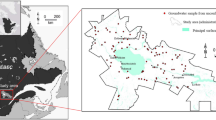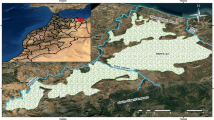Abstract
With the aim of developing procedures coping with the disadvantages and emphasising the advantages of existing rating methods and the use of statistical methods for assessing groundwater vulnerability, we propose to combine the two approaches to perform a groundwater vulnerability assessment in a study area in Italy. In the case study, located in an area of northern Italy with both urban and agricultural sectors, keeping the structure of the DRASTIC rating method, we used a spatial statistical approach to calibrate weights and ratings of a series of variables, potentially affecting groundwater vulnerability. In order to verify the effectiveness of these procedures, the results were compared to a non-modified approach and to the map resulting from the “Time–Input” method, highlighting the advantages that can be obtained, and defining the general limit of these applications. The revised method shows a more realistic distribution of vulnerability classes in accordance with the distribution of wells impacted by high nitrate concentration, demonstrating the importance of taking into account the specific hydrogeological conditions of the area.








Similar content being viewed by others
References
Aller L, Bennett T, Lehr JH, Petty RJ, Hackett G (1987) DRASTIC: a standardized system for evaluating ground water pollution potential using hydrogeologic settings. NWWA/EPA Series, EPA-600/2-87-035
Anane M, Abidi B, Lachaal F, Limam A, Jellali S (2013) GIS-based DRASTIC, Pesticide DRASTIC and Susceptibility Index (SI): comparative study for evaluation of pollution potential in the Nabeul-Hammamet shallow aquifer Tunisia. Hydrogeol J 21:715–731
Baker DB (1990) Groundwater quality assessment through cooperative private well testing: an Ohio example. J Soil Water Conserv 45:230–235
Best A, Arnaud E, Parker B, Aravena R, Dunfield K (2015) Effects of glacial sediment type and land use on nitrate patterns in groundwater. Groundw Monit Remediat 35(1):68–81
Bonham-Carter GF (1994) Tools for map analysis: map pairs. In: Merriam DF (ed) Geographic information systems for geoscientist: modelling with GIS. Pergamon, New York
Cinnirella S, Buttafuoco G, Pirrone N (2005) Stochastic analysis to assess the spatial distribution of groundwater nitrate concentrations in the Po catchment (Italy). Environ Pollution 133(3):569–580
Cowan N (2001) The magical number 4 in short-term memory: a reconsideration of mental storage capacity. Behav Brain Sci 24:87–185
Doerfliger N, Zwahlen F (1997) EPIK: a new method for outlining of protection areas in karstic environment. In: Günay G, Jonshon AI (eds) International symposium and field seminar on karst waters and environmental impacts. Balkema, Antalya, pp 117–123
Ducci D, Sellerino M (2013) Vulnerability mapping of groundwater contamination based on 3D lithostratigraphical models of porous aquifers. Sci Total Environ 447:315–322
ERSAF Ente Regionale per i Servizi all’Agricoltura e alle Foreste (2014) DUSAF (Destinazione d’Uso dei Suoli Agricoli e forestali) [Land use database]. http://www.cartografia.regione.lombardia.it/. Accessed 28 Feb 2014
European Community (1991) Council Directive 91/676/EEC concerning the protection of waters against pollution caused by nitrates from agricultural sources. OJ L 375, 31 December 1991, pp 1–8
Foster S (1987) Fundamental concepts in aquifer vulnerability, pollution risk and protection strategy. In: Duijvenbooden WV, Waegeningh HGV (eds) Vulnerability of soil and groundwater to pollutants. proceedings and information, TNO Committee on Hydrological Research 38:69–86
Foster S, Hirata R, Andreo B (2013) The aquifer pollution vulnerability concept: aid or impediment in promoting groundwater protection? Hydrogeol J 21:1389–1392
Gogu RC, Dassargues A (2000) Current trends and future challenges in groundwater vulnerability assessment using overlay and index methods. Environ Geol 39(6):549–559
Hamza MH, Added A, Rodrıguez R, Abdeljaoued S, Ben Mammou A (2007) A GIS-based DRASTIC vulnerability and net recharge reassessment in an aquifer of a semi-arid region (Metline-Ras Jebel-Raf Raf aquifer, Northern Tunisia). J Environ Manage 84:12–19
Howard KWF (1997) Impacts of urban development on groundwater. In: Eyles N (ed) Environmental geology of urban areas. Special publication of the Geological Association of Canada. Geotext 3:93–104
Kolpin D, Burkart M, Goolsby D (1999) Nitrate in groundwater of the Midwestern United States: a regional investigations on relations to land use and soil properties. In: Heathwaite L (ed) Impact of land-use change on nutrient loads from diffuse sources (Proceedings of IUGG 99 Symposium HS3, Birmingham, July 1999). IAHS Publication No, Denmark, p 257
Kralik M (2008) The Time-Input vulnerability method and hazard assessment at a test site in the Front Range of the Eastern Alps. Groundwater Modelling, International symposium on groundwater Flow and Transport Modelling. Proceedings of Invited Lectures, pp 39–44
Kralik M, Keimel T (2003) Time-Input, an innovative groundwater-vulnerability assessment scheme: application to an alpine test site. Environ Geol 44:679–686
Lombardia Regione, Agip Eni Divisione (2002) Geologia degli acquiferi Padani della Regione Lombardia [Geology of the Po Valley aquifers in Lombardy Region]. S.EL.CA, Firenze
Masetti M, Poli S, Sterlacchini S, Beretta GP, Facchi A (2008) Spatial and statistical assessment of factors influencing nitrate contamination in groundwater. J Environ Manage 86:272–281
Masetti M, Sterlacchini S, Ballabio C, Sorichetta A, Poli S (2009) Influence of threshold value in the use of statistical methods for groundwater vulnerability assessment. Sci Total Environ 407:3836–3846
Nolan BT (2001) Relating nitrogen sources and aquifer susceptibility to nitrate in shallow ground water of the United States. Ground Water 39(2):290–299
Nolan BT, Hitt KJ, Ruddy BC (2002) Probability of nitrate contamination of recently recharged groundwaters in the conterminous United States. Environ Sci Technol 36(10):2138–2145
Raines GL (1999) Evaluation of weights of evidence to predict epithermal-gold deposits in the great basin of the Western United States. Nat Resour Res 8(4):257–276
Rupert MG (2001) Calibration of the DRASTIC ground water vulnerability mapping method. Ground Water 39(4):625–630
Sorichetta A, Masetti M, Ballabio C, Sterlacchini S, Beretta GP (2011) Reliability of groundwater vulnerability maps obtained through statistical methods. J Environ Manage 92:1215–1224
Sorichetta A, Masetti M, Ballabio C, Sterlacchini S (2012) Aquifer nitrate vulnerability assessment using positive and negative weights of evidence methods, Milan, Italy. Comput Geosci 48:199–210
Sorichetta A, Ballabio C, Masetti M, Robinson GR Jr, Sterlacchini S (2013) A comparison of data-driven groundwater vulnerability assessment methods. Ground Water 51(6):866–879
Tesoriero A, Voss F (1997) Predicting the probability of elevated nitrate concentrations in the Puget sound basin: implications for aquifer susceptibility and vulnerability. Ground Water 35(6):1029–1039
Wachniew P, Zurek AJ, Stumpp C, Gemitzi A, Gargini A, Filippini M, Witczak S (2016) Towards operational methods for the assessment of intrinsic groundwater vulnerability: a review. Crit Rev Environ Sci Technol. doi:10.1080/10643389.2016.1160816
Wick K, Heumesser C, Schmid E (2012) Groundwater nitrate contamination: factors and indicators. J Environ Manage 111:178–186
Zwahlen F (2004) Vulnerability and risk mapping for the protection of carbonate (karst) aquifers, final report (COST action 620). European Commission, Directorate-General XII Science, Research and Development, Brussels
Author information
Authors and Affiliations
Corresponding author
Additional information
This article is a part of a Topical Collection in Environmental Earth Sciences on “Groundwater Vulnerability,” edited by Dr. Andrzej Witkowski.
Rights and permissions
About this article
Cite this article
Bonfanti, M., Ducci, D., Masetti, M. et al. Using statistical analyses for improving rating methods for groundwater vulnerability in contamination maps. Environ Earth Sci 75, 1003 (2016). https://doi.org/10.1007/s12665-016-5793-0
Received:
Accepted:
Published:
DOI: https://doi.org/10.1007/s12665-016-5793-0




